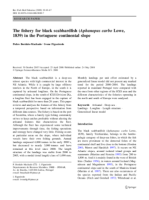Fishery of black scabbardfish in Portugal mainland

The black scabbardfish is a deep-sea teleost species with high commercial interest in the NE Atlantic. While it is caught by large offshore trawlers in the North of Europe, in the south it is captured by artisanal longlines. On the Portuguese continental slope, in the south of ICES Division IXa, a longline fleet has been engaged in the capture of black scabbardfish for more than 20 years.
This paper reviews and analyses the features of this fishery from a temporal perspective based on information from different data sources. The fishery is based on the port of Sesimbra, where a family type fishing community strives to keep catches profitable without altering the artisanal features that characterizes the fleet.
Although the fleet has experienced some technical improvements through time, the fishing operations and strategy have changed very little. Fishing occurs at particular areas on the slope, where individual vessels have their own fishing grounds. Annual landings surpassed 4,000 tonnes in the early 1990’s, but decreased to nearly 3,000 tonnes and have remained at this level since 2000. The length structure of the landings was stable from 2000 to 2005, with a modal (total length) class of 1,090 mm. Monthly landings per unit effort estimated by a generalized linear model did not present any marked trend for the period 2000–2004.
The landings reported in mainland Portugal were compared with the ones from other regions of the ICES area and the different characteristics of the fisheries operating in the north and south of Europe were analysed.







